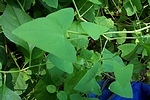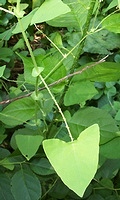Fight Back Against Mile-a-Minute Vine
Volunteers are gathering across the lower Hudson Valley in an effort to block the spread of an invasive plant called mile-a-minute vine. A coalition of groups is sponsoring the effort, including the state Department of Environmental Conservation, Bear Mountain State Park, and the Invasive Plant Council of New York.
Locally, Margie Turrin, an education coordinator at Lamont-Doherty is actively involved in recruiting volunteers to help pull up vines.
Interested people can meet her at 9 a.m. on Saturday, June 24 at Tackamack Park (on Clausland Mountain Rd. in Blauvelt) for a day outing aimed at pulling up vines along the ridge on Clausland Mountain.
Additional information about invasive species in our area can be found at the invasive plant council's website: www.ipcnys.org/.
Mile-a-Minute Vine - Overview (Information from IPCNYS)
Mile-a-minute vine is native to East Asia. It was introduced to the United States accidentally: it arrived at a nursery in York County, Pennsylvania with a shipment of Rhododendrons.
Mile-a-minute vine, as the name suggests, can grow very rapidly: up to 15 cm/day. It has thorny stems which can create an impenetrable wall. The barbs lead to its other common name, devil’s tear-thumb. The vine grows over anything in its path including trees and Phragmites.
Mile-a-minute vine has shallow roots and is fairly easy to hand-pull. The seeds appear to be viable for up to 5 years, so sites targeted for removal need to be monitored regularly to remove new seedlings before they have a chance to grow.
Known mile-a-minute vine locations in New York are limited to Long Island and the Lower Hudson Valley, at this point in time. Mile-a-minute vine is listed as a Noxious Weed in Pennsylvania.
Early detection and rapid response of mile-a-minute infestations in the Hudson Valley and Long Island could make a significant difference for the rest of the state. Please contact IPC if you know of additional mile-a-minute locations in New York and/or you are willing to help some local volunteers with their removal efforts.



